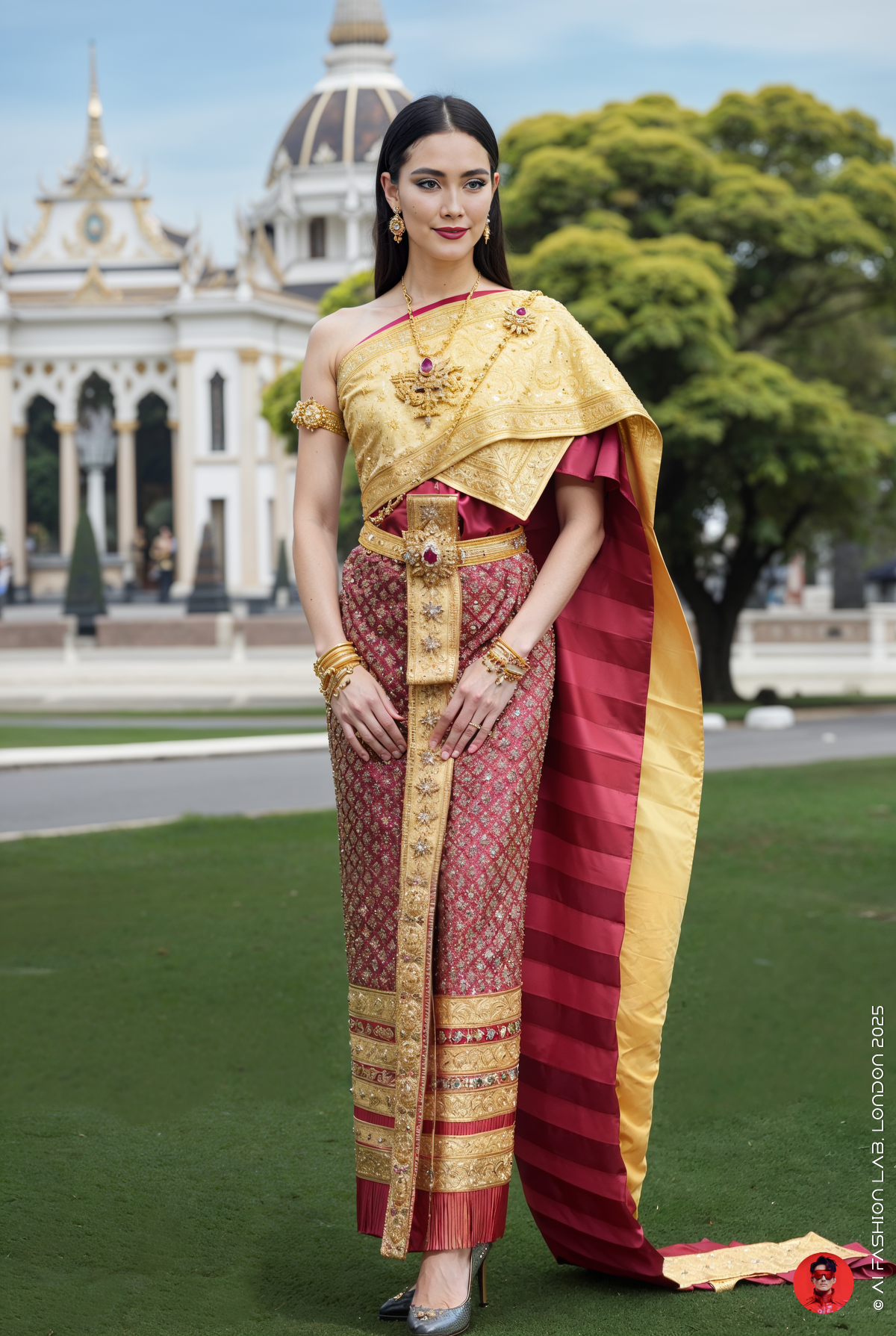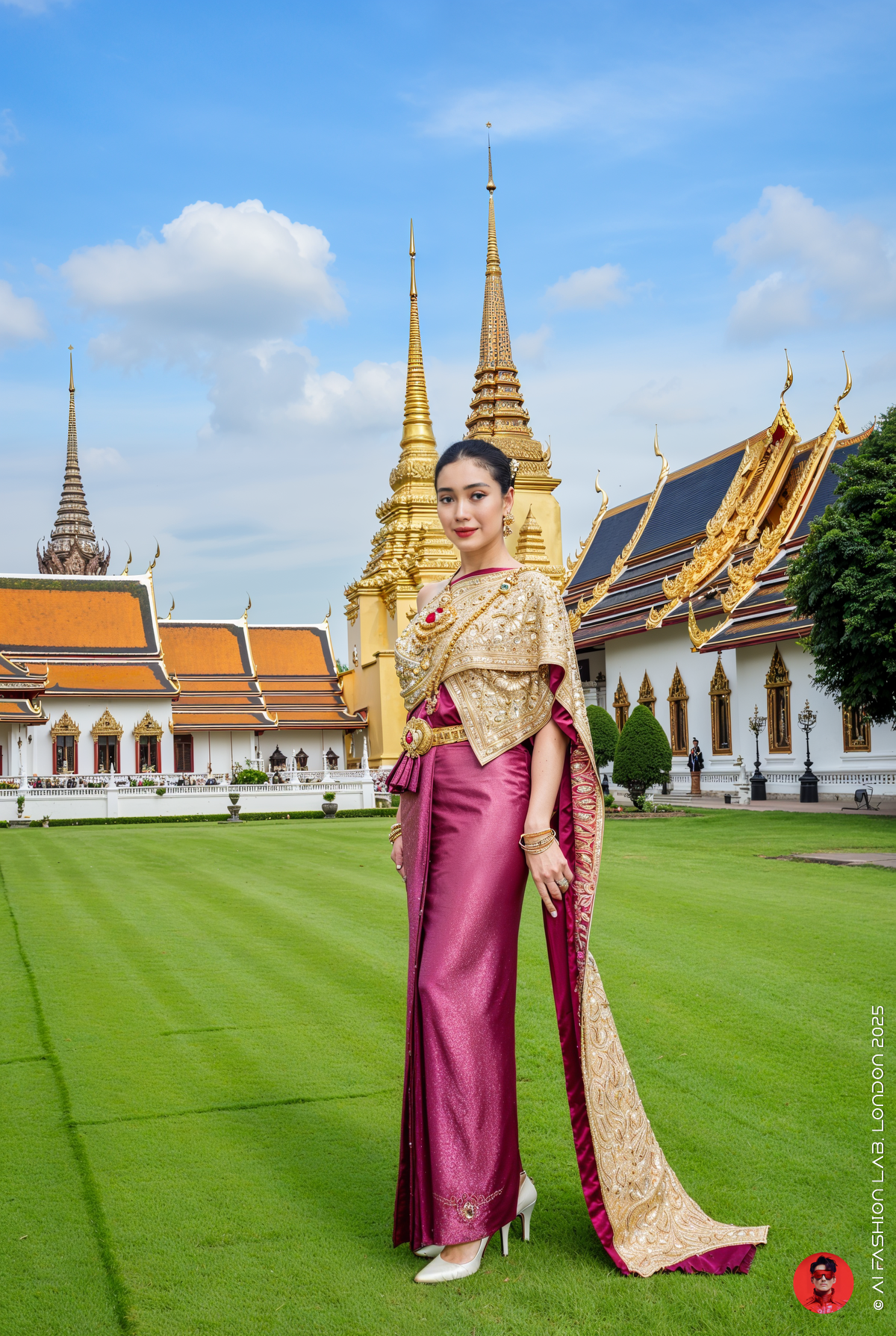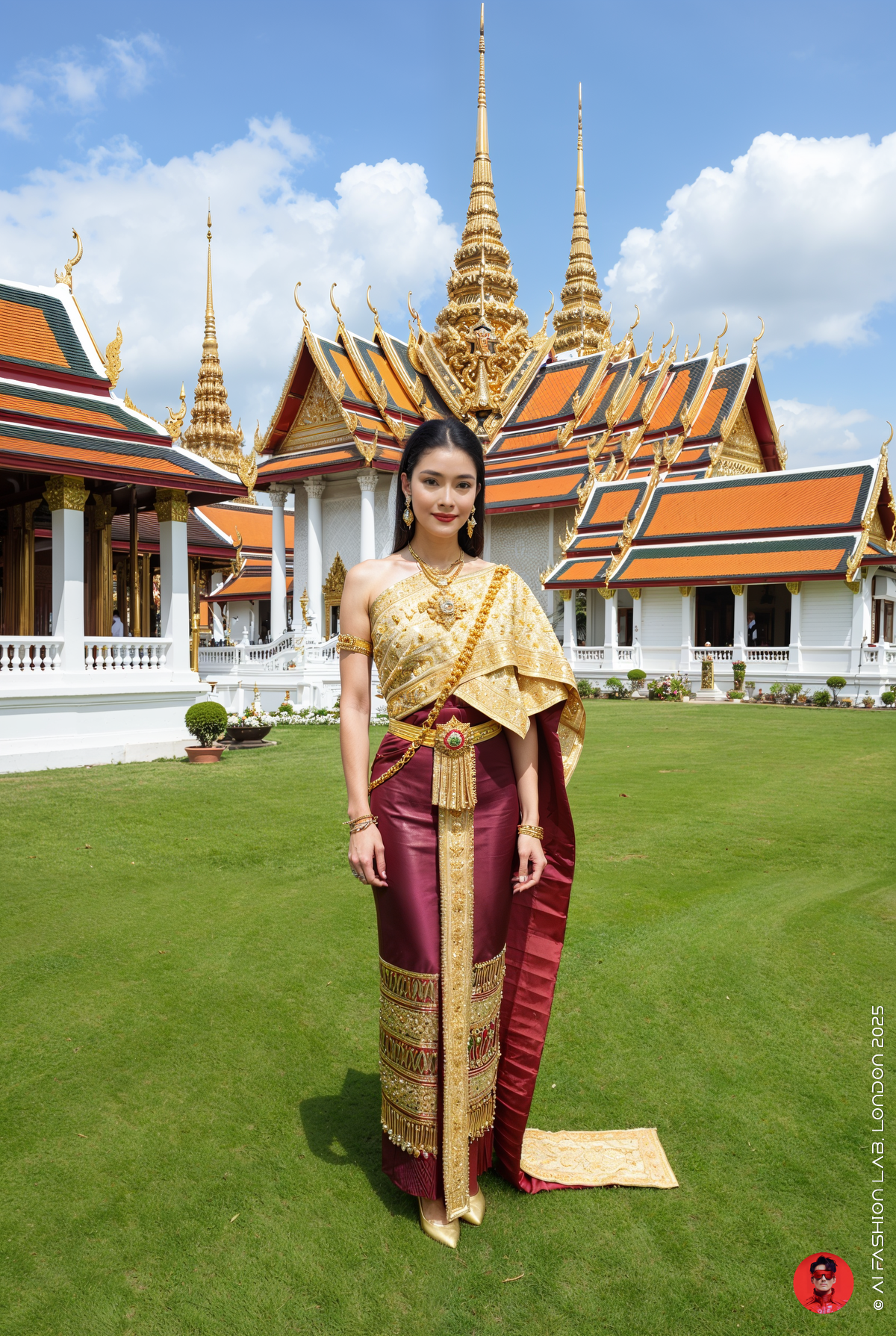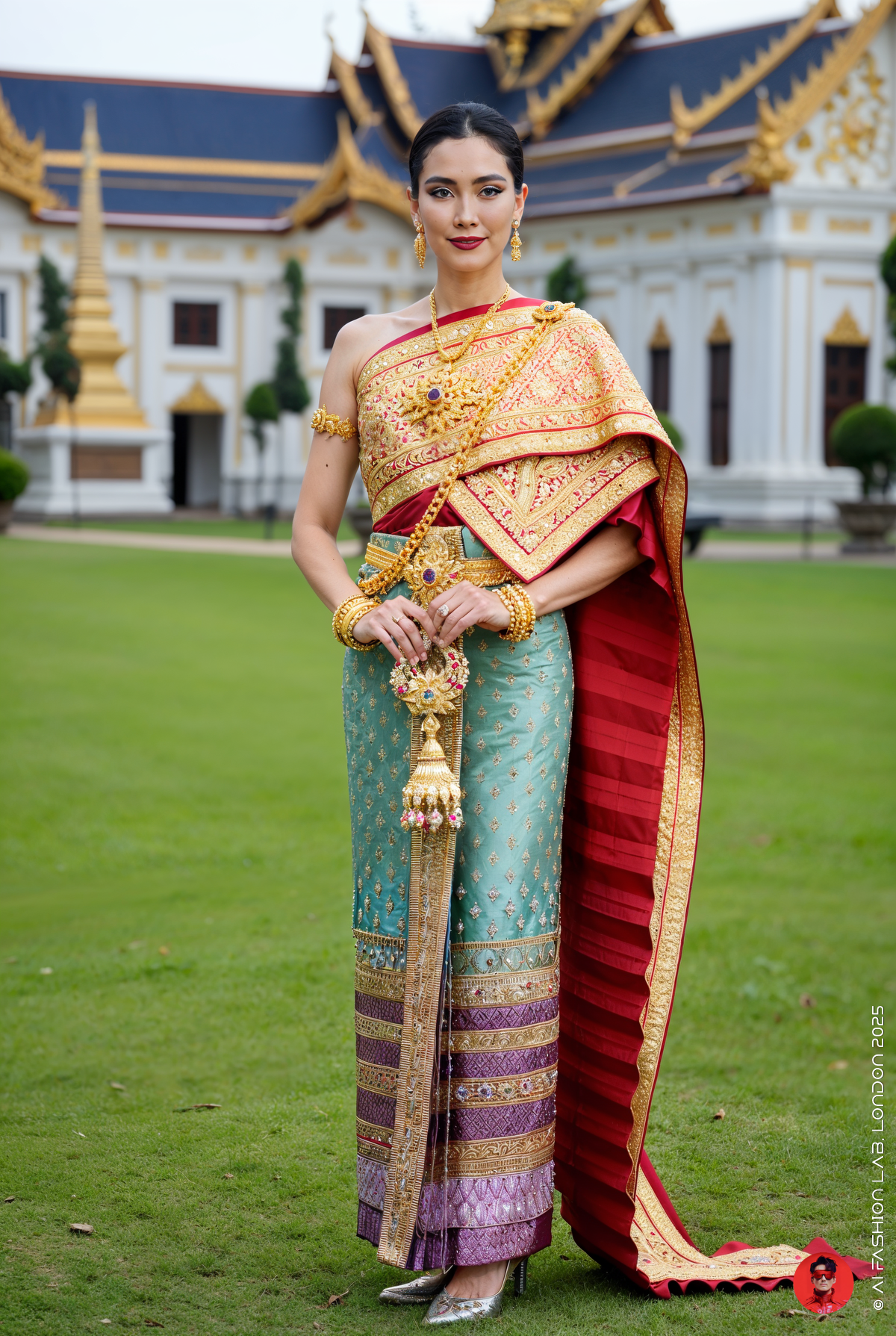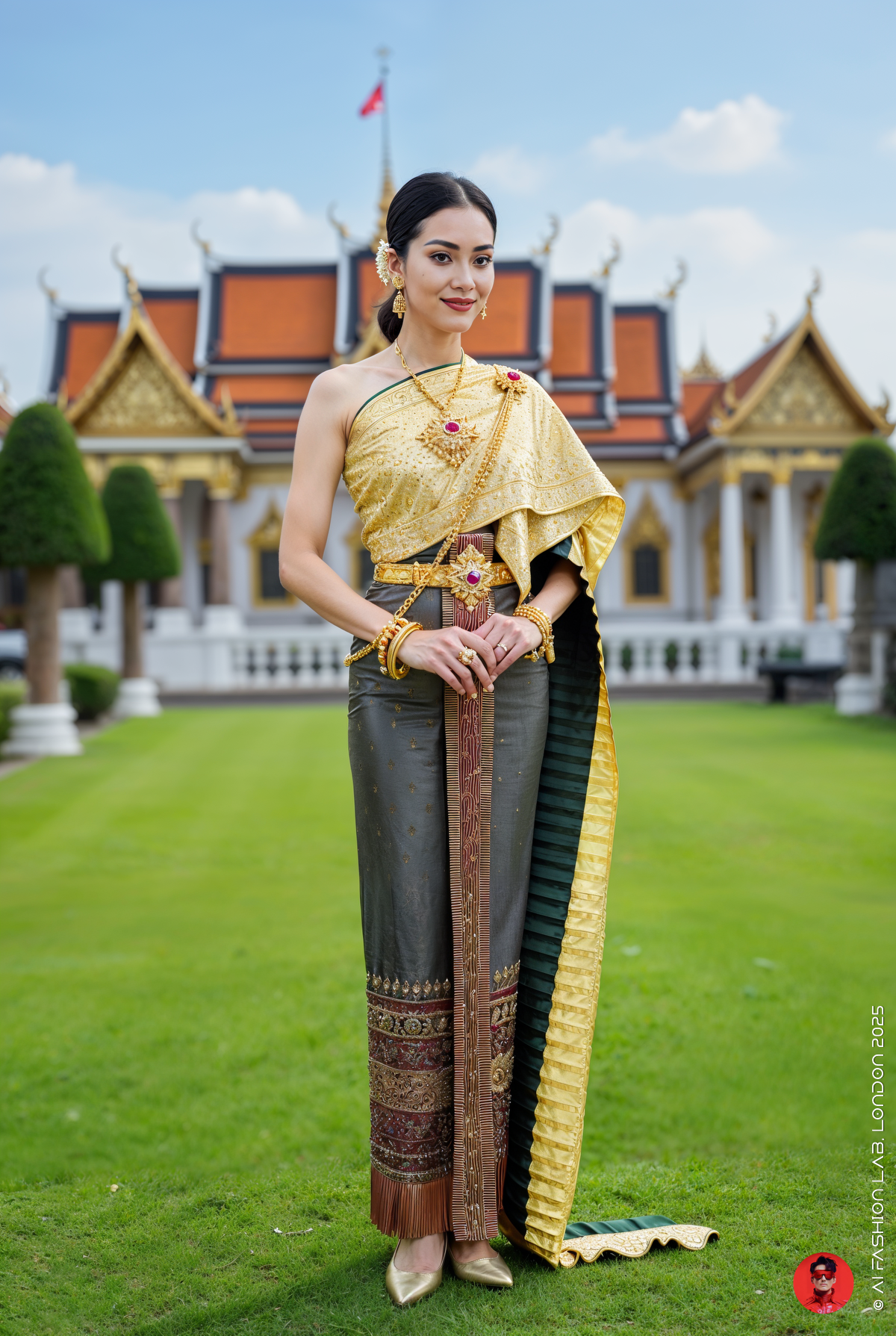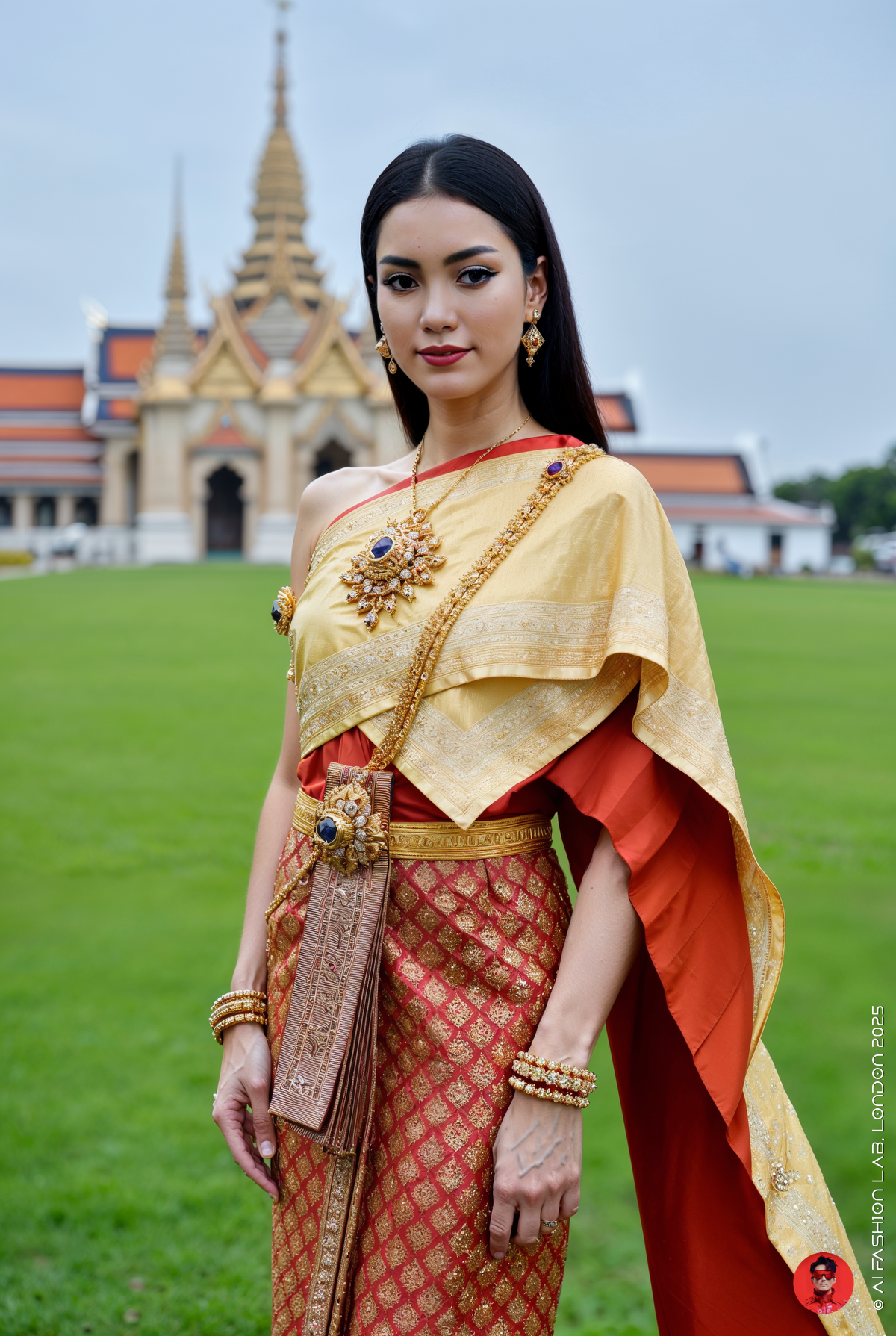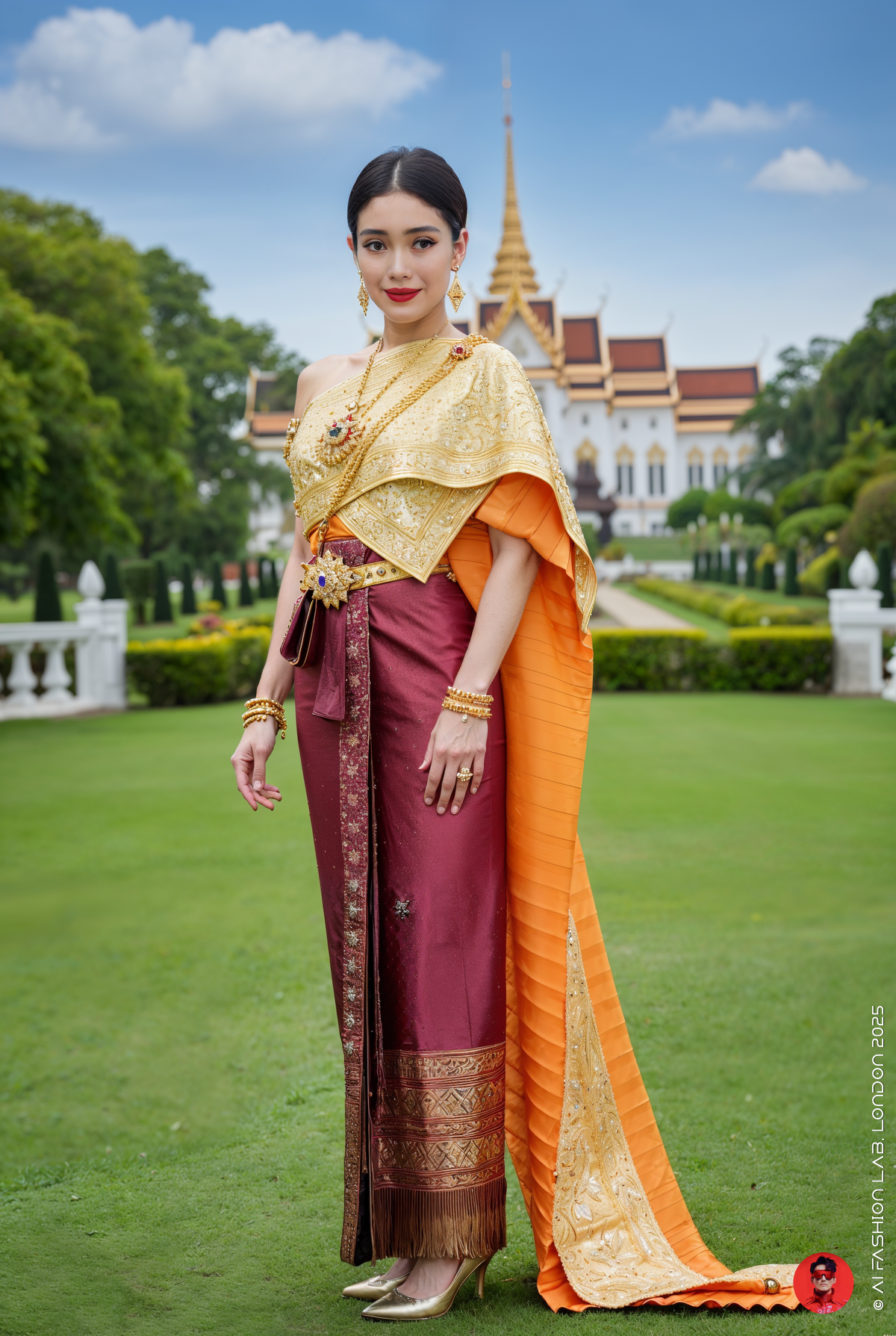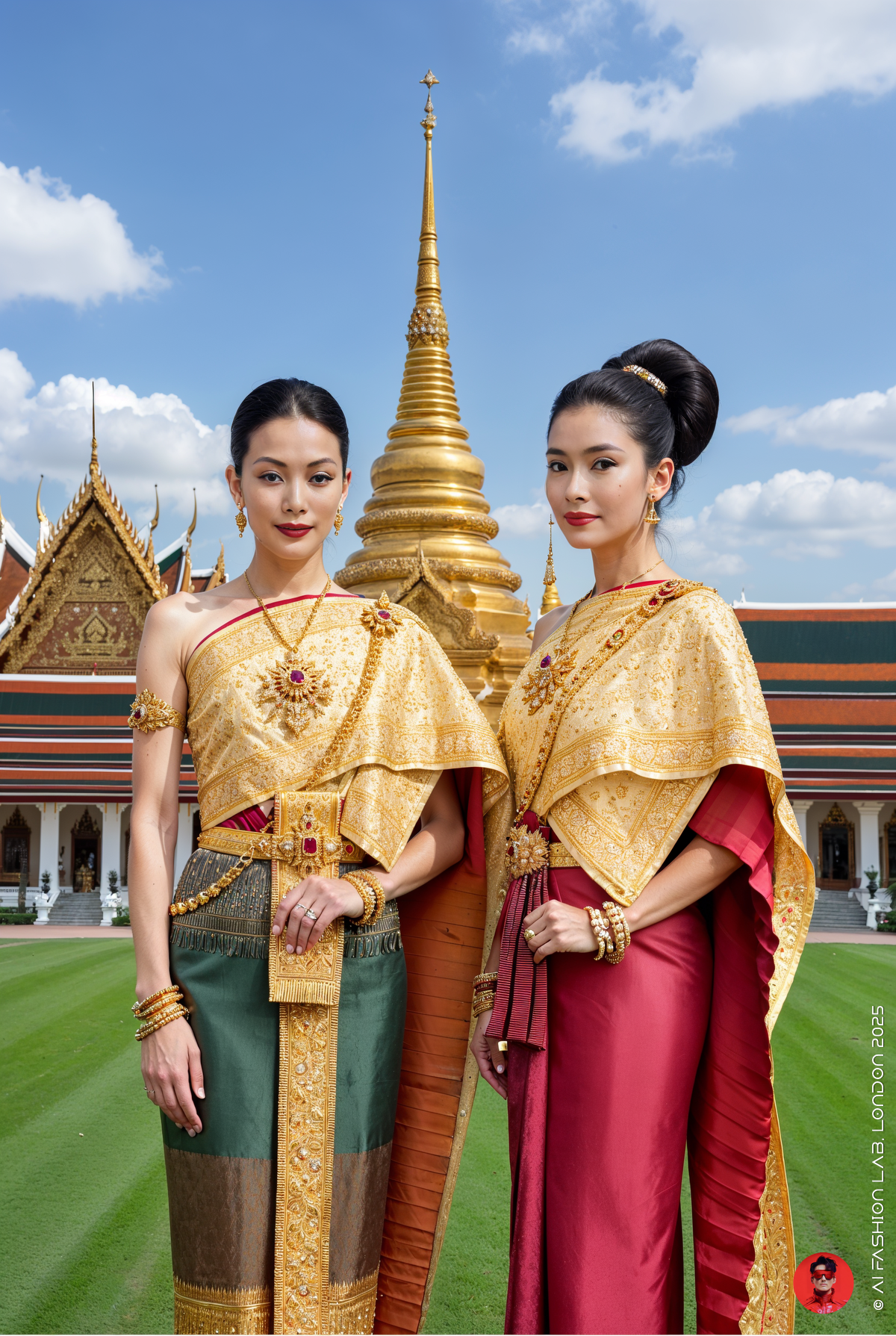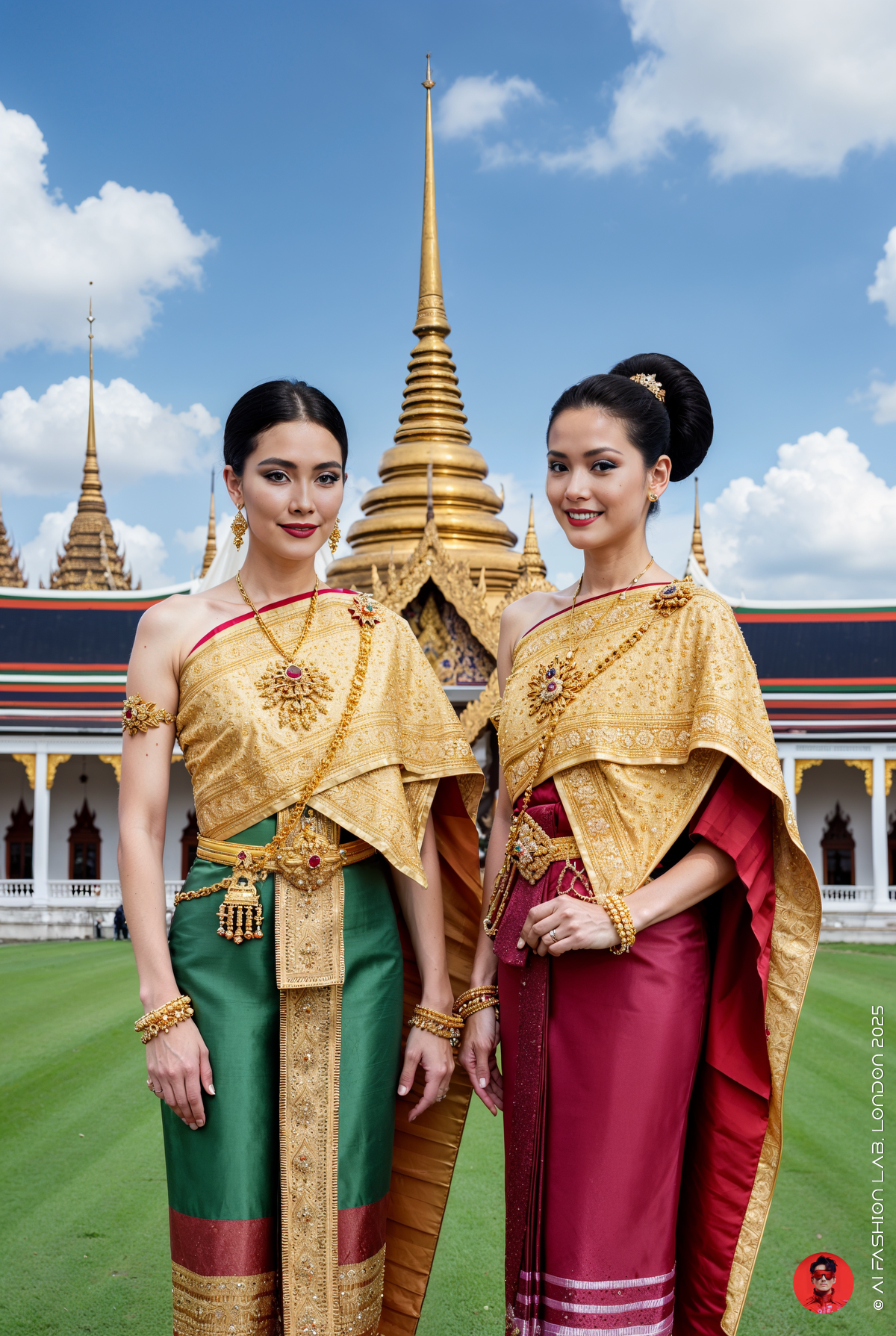ชุดไทยจักรพรรดิ์ ชุดไทยพระราชนิยม เครื่องแต่งกายประจำชาติและความภาคภูมิใจในความเป็นไทย (๘ ใน ๘)(ตอนที่ ๒)
ชุดไทยจักรพรรดิ์ ชุดไทยพระราชนิยม — การแต่งกายและความภูมิใจในความเป็นไทย (ชุดไทยพระราชนิยม แบบที่ ๘ ใน ๘ แบบ) (ตอนที่ ๒)
AI Collection ชุดนี้ ได้รับแรงบันดาลใจจากสมเด็จพระนางเจ้าสิริกิติ์ พระบรมราชินีนาถ พระบรมราชชนนีพันปีหลวง และ “ชุดไทยพระราชนิยม” ทั้ง ๘ แบบ ซึ่งทรงมีพระราชดำริให้จัดสร้างขึ้นระหว่างปี พ.ศ. ๒๕๐๓–๒๕๐๔ เพื่อให้สตรีไทยมีแบบอย่างการแต่งกายที่งดงาม เหมาะสมกับกาลเทศะ และสะท้อนอัตลักษณ์ความเป็นไทยอย่างสง่างามในระดับสากล
ด้วยความตั้งใจนี้ ผมจึงรังสรรค์ AI Collection ที่นำเสนอชุดไทยพระราชนิยมทั้ง ๘ แบบ ผ่านมุมมองร่วมสมัย โดยผสมผสานกลิ่นอายของแฟชั่นยุค 1960s อย่างกลมกลืน ทั้งในด้านทรงผม องค์ประกอบภาพ ไปจนถึงแสงและเงา เนื่องจากชุดไทยพระราชนิยมถือกำเนิดขึ้นในช่วงเวลานั้น อีกทั้งในปีหน้า #UNESCO มีแนวโน้มจะประกาศขึ้นทะเบียน “ชุดไทยพระราชนิยม” ให้เป็นมรดกภูมิปัญญาทางวัฒนธรรมของโลก เราทุกคนจึงควรร่วมภาคภูมิใจ อนุรักษ์ และส่งต่อมรดกอันทรงคุณค่านี้สู่อนาคต
ชุดไทยจักรพรรดิ: เครื่องแต่งกายอันวิจิตรของสตรีชั้นสูงในงานพิธีระดับชาติ
ชุดไทยจักรพรรดิ เป็นหนึ่งในชุดไทยพระราชนิยมที่สง่างามและมีพิธีรีตองสูงสุดในหมู่เครื่องแต่งกายสตรีแบบไทย ได้รับการตั้งชื่อตาม พระที่นั่งจักรพรรดิพิมาน ซึ่งเป็นส่วนหนึ่งของพระบรมมหาราชวัง โดยเป็นชุดที่สื่อถึงความโอ่อ่า ความสุภาพ และสถานะทางสังคมของผู้สวมใส่อย่างเด่นชัด
ลักษณะเด่นของชุดไทยจักรพรรดิ
จุดเด่นของชุดนี้คือ การห่มสไบแบบสองชั้น ชั้นในเป็นสไบจีบผ้าแพรสีเรียบหรือสไบทึบ ห่มแนบลำตัวอย่างประณีต ส่วนสไบชั้นนอกเป็นสไบปักดิ้นทองหรือปักลูกปัดงดงามวิจิตรในแบบสตรีบรรณาศักดิ์สมัยโบราณ โดยสไบชั้นนอกนี้มักทิ้งชายยาวพาดหลังจรดปลายผ้าซิ่น สื่อถึงความอ่อนช้อยและภูมิฐานของสตรีในราชสำนัก
สไบชั้นนอกนี้ เรียกอีกชื่อหนึ่งว่า “สะพัก” หรือ “การห่มสะพัก” ซึ่งถือเป็นธรรมเนียมโบราณที่ใช้เฉพาะในโอกาสพิเศษ เป็นการห่มผ้าอีกชั้นหนึ่งทับสไบจีบด้านใน เพื่อแสดงความสุภาพเรียบร้อยต่อหน้าธารกำนัล โดยเฉพาะในยุคก่อนที่ยังไม่มีการสวมใส่ชุดชั้นในอย่างแพร่หลาย การห่มสไบเพียงชั้นเดียวจึงถือว่าไม่มิดชิดเพียงพอในงานพิธี การห่มสะพักจึงไม่เพียงเสริมความงาม หากยังเป็นสัญลักษณ์ของกิริยาอ่อนช้อยและการให้เกียรติผู้ร่วมพิธีอีกด้วย นอกจากนี้ การห่มสะพักยังสะท้อนสถานะทางสังคม ของผู้สวมใส่ในยุคโบราณได้อย่างชัดเจน ยิ่งผืนสไบปักอย่างประณีตด้วยดิ้นทอง ลูกปัด หรือไหมยกฝีมือชั้นครูมากเพียงใด ก็ยิ่งบ่งบอกถึงความสูงศักดิ์และความมั่งคั่งของสตรีผู้นั้นได้อย่างเด่นชัด
ผ้าซิ่นและการนุ่งห่ม
ผ้าซิ่นที่ใช้ในชุดไทยจักรพรรดิเป็น ผ้าไหมยกดิ้นทอง หรือ ผ้าไหมยกเชิงสีทอง นุ่งแบบจีบหน้านาง มีชายพก นิยมเลือกแบบที่มีลวดลายวิจิตรบนผืนผ้า ความยาวซิ่นกรอมข้อเท้า และมักคาด เข็มขัดทองแบบไทย เพื่อเน้นช่วงเอวและยึดชายผ้าให้เรียบร้อย
เครื่องประดับ
ชุดนี้มักสวมคู่กับเครื่องประดับชั้นสูงแบบราชสำนัก ได้แก่
รัดเกล้า: เครื่องประดับสำหรับรวบมวยผมไว้กลางกระหม่อม
สร้อยคอ และ สร้อยข้อมือ ที่ประดับด้วยทองคำหรืออัญมณี
ต่างหู และ สังวาลย์ ที่ห้อยทับสไบเพื่อเพิ่มความงาม
โอกาสในการสวมใส่
ในอดีต ชุดไทยจักรพรรดิ ใช้สำหรับ พระราชพิธี และ งานพิธีรับรองระดับชาติ โดยเฉพาะในช่วงค่ำ อาทิ การถวายเลี้ยงพระมหากษัตริย์ต่างประเทศหรืองานเฉลิมพระเกียรติ ปัจจุบันชุดนี้ได้รับความนิยมอย่างสูงในฐานะชุดเจ้าสาวสำหรับงานเลี้ยงฉลองในช่วงค่ำ ด้วยภาพลักษณ์ที่วิจิตร หรูหรา และเปี่ยมด้วยความหมายทางวัฒนธรรม
พระราชนิยมในการใช้ผ้าไทย: พระปณิธานของสมเด็จพระนางเจ้าฯ พระบรมราชินีนาถ
สมเด็จพระนางเจ้าฯ พระบรมราชินีนาถ ทรงมีพระราชนิยมในการใช้ ผ้าไทย มาตั้งแต่ยังทรงพระเยาว์ เมื่อครั้งสมเด็จพระเจ้าอยู่หัวมีพระราชดำริจะทรงประกาศหมั้น นักหนังสือพิมพ์ต่างประเทศได้ขอสัมภาษณ์พระองค์ ซึ่งพระองค์ทรงตอบอย่างชัดเจนว่า จะสนับสนุนและส่งเสริมการแต่งกายแบบไทย
ในโอกาสนั้น พระองค์ในฐานะ “พระคู่หมั้น” ทรงเลือกใช้ ผ้าไหมไทย และ ซิ่นไทย สำหรับชุดต่าง ๆ รวมถึง ฉลองพระองค์ในพระราชพิธีอภิเษกสมรส ก็ทรงใช้ผ้าไทยอย่างภาคภูมิ ภายหลังจากพระราชพิธีดังกล่าว พระองค์ทรงยึดมั่นในพระราชปณิธาน และทรงพระกรุณาโปรดให้สร้าง “เครื่องแต่งกายแบบไทยตามพระราชนิยม” ขึ้น จนกลายเป็น เครื่องแต่งกายประจำชาติของสตรีไทย มาจนถึงปัจจุบัน
ในสมัยที่เสด็จฯ เยือนประเทศเพื่อนบ้านเป็นครั้งแรก ยังไม่มีการกำหนดชุดไทยตามแบบพระราชนิยม พระองค์จึงทรงริเริ่มออกแบบฉลองพระองค์โดยใช้ ผ้าไหมไทย ผ้ายก และผ้าพื้นถิ่นไทย ต่าง ๆ มาตัดเย็บและประดิษฐ์ตกแต่ง เพื่อให้สื่อถึงอัตลักษณ์ของความเป็นไทย โดยทรงเจริญรอยตามสมเด็จพระพันปีหลวง สมเด็จพระศรีพัชรินทรา บรมราชินีนาถ
ชุดไทยพระราชนิยมทั้ง 8 แบบ ได้แก่
ชุดไทยเรือนต้น – เรียบง่าย เหมาะสำหรับงานไม่เป็นทางการหรือสวมใส่ในชีวิตประจำวัน
ชุดไทยจิตรลดา – สุภาพ เหมาะสำหรับงานพิธีการเล็กน้อยหรือรับรองแขก
ชุดไทยอมรินทร์ – งดงาม เหมาะกับงานราตรีหรืองานพิธีสำคัญ
ชุดไทยบรมพิมาน – ผ้าไหมลายสวย ใช้ในงานพิธีการและงานทางการ
ชุดไทยจักรี – หรูหรา สง่างาม เหมาะกับงานพิธีระดับสูง
ชุดไทยดุสิต – ใช้ผ้าไหมลวดลาย ปักลายวิจิตร สำหรับงานราตรีหรืองานฉลอง
ชุดไทยศิวาลัย – หรูหรา เน้นเครื่องประดับ ใช้ในงานพิธีสำคัญ
ชุดไทยจักรพรรดิ์ – สง่างามที่สุด ใช้ในงานพิธีใหญ่ระดับราชสำนัก
Chud Thai Chakkraphat - Chud Thai Phra Ratcha Niyom – National Dress and a Symbol of Thai Identity
(Style No. 8 of the 8 official designs in the Chud Thai Phra Ratcha Niyom collection)(Part 2)
This AI Collection draws inspiration from Her Majesty Queen Sirikit The Queen Mother and the full series of eight Chud Thai Phra Ratcha Niyom (ชุดไทยพระราชนิยม), which were developed under her royal initiative between 1960 and 1961. The goal was to create refined and graceful national attire for Thai women—garments that reflect Thai cultural identity and are appropriate for ceremonial functions and state occasions.
To honour this visionary royal initiative, I have created an AI Collection that reimagines all eight styles through a contemporary perspective. Each image is infused with the charm of 1960s vintage fashion—the era in which these national dresses first emerged. Lighting, hairstyle, and composition have all been meticulously crafted to convey the beauty of this cultural moment in Thai history.
Royal Patronage of Thai Textiles: Her Majesty’s Lifelong Commitment
Her Majesty Queen Sirikit The Queen Mother has embraced Thai textiles since her youth. When His Majesty King Bhumibol Adulyadej (Rama IX) intended to announce their engagement, foreign journalists interviewed Her Majesty, who expressed her firm commitment to promoting Thai dress. At the time, as the royal fiancée, she chose to wear Thai silk and traditional Thai sinh in various ensembles. Notably, she wore Thai fabrics with pride during the Royal Wedding Ceremony.
After the ceremony, Her Majesty continued to champion Thai textiles, graciously initiating the creation of the Chud Thai Phra Ratcha Niyom—a series of formal national dresses for Thai women, now recognised as a vital part of Thailand’s cultural identity. During her first state visits to neighbouring countries, when no official Thai national dress had yet been established, Her Majesty began designing her formal attire using Thai silk, brocade, and regional Thai textiles. These designs reflected the essence of Thai identity and followed in the footsteps of Queen Saovabha Phongsri (Queen Sri Bajarindra), consort of King Chulalongkorn (Rama V), who had once served as Queen Regent.
Chud Thai Phra Ratcha Niyom (ชุดไทยพระราชนิยม)
Chud Thai Phra Ratcha Niyom refers to the formalised series of Thai national dresses for women, used in ceremonies, weddings, and official events. These garments are characterised by specific patterns, fabrics, and decorative details. Common materials include silk, cotton, and synthetic fibres in plain colours, floral prints, stripes, or intricately woven patterns using metallic threads. Decorations may include fabric-covered buttons, zippers, or hooks, and sometimes delicate embellishments such as pearls, sequins, or beadwork.
Common fabrics used:
Thai silk – woven from natural silk fibres
Cotton – made from natural cotton threads
Synthetic fibres – such as polyester, rayon, jersey, or Toray
The Eight Styles of Chud Thai Phra Ratcha Niyom
Chud Thai Ruean Ton (ชุดไทยเรือนต้น) – Simple, ideal for informal or everyday wear
Chud Thai Chitralada (ชุดไทยจิตรลดา) – Modest, suitable for semi-formal events or diplomatic receptions
Chud Thai Amarin (ชุดไทยอมรินทร์) – Elegant, appropriate for evening functions or formal ceremonies
Chud Thai Boromphiman (ชุดไทยบรมพิมาน) – Refined, typically made of patterned silk for ceremonial use
Chud Thai Chakri (ชุดไทยจักรี) – Luxurious and stately, ideal for high-level royal functions
Chud Thai Dusit (ชุดไทยดุสิต) – Decorated with intricate patterns, suitable for gala dinners or celebrations
Chud Thai Siwalai (ชุดไทยศิวาลัย) – Ornate and jewel-accented, designed for important royal ceremonies
Chud Thai Chakkraphat (ชุดไทยจักรพรรดิ์) – The most majestic, reserved for grand palace occasions
Chud Thai Chakkraphat: Symbol of Grandeur, Grace, and Nobility
Among all the Chud Thai styles, Chud Thai Chakkraphat stands as the most majestic. It is named after Phra Thi Nang Chakkraphat Phiman, a grand throne hall within the Grand Palace, and is the most ceremonially elaborate of the eight royal Thai costumes. This ensemble embodies elegance, dignity, and a clear expression of noble status.
The defining feature of Chud Thai Chakkraphat is the double-layered shawl draping. The inner shawl is a neatly pleated plain silk (sabai), wrapped tightly against the upper body. Over this, a second shawl—often richly adorned with gold thread embroidery or beading—is draped across one shoulder. This outer layer is known as the saphak (สะพัก), a term referring specifically to the draping style that signifies respect and modesty, particularly in formal settings.
In earlier times, when undergarments were not commonly used, the saphak served a dual purpose: enhancing the beauty of the outfit while ensuring the wearer appeared properly modest and dignified in public. Beyond function, the intricacy and luxury of the saphak—especially when made with masterfully brocaded silk, gold thread, or ornate beadwork—also denoted the wearer’s high social rank and noble lineage.
The Skirt and Accessories
The skirt (sinh) worn with Chud Thai Chakkraphat is typically made from gold-threaded silk brocade or silk with golden borders. It is worn in the traditional jeeb na nang style (pleated front with a folded panel) and includes a chai pok(decorative tab at the back). The hem reaches the ankles, and a traditional gold belt is worn at the waist to secure and accentuate the silhouette.
This opulent ensemble is completed with court-style jewellery, including:
Rad klao – a tiara-like ornament for the topknot
Necklaces and bracelets – made of gold or adorned with gemstones
Earrings and a sangwan – an ornamental chain draped elegantly over the sabai
Occasions for Wearing Chud Thai Chakkraphat
Traditionally reserved for state ceremonies and royal functions, Chud Thai Chakkraphat is most often worn during evening events of national significance, such as royal banquets or receptions for visiting heads of state. In modern times, it has become a popular choice for brides during formal evening wedding receptions, treasured for its splendour, cultural depth, and symbolic elegance.
#aifashionlab #AI #aiartist #aiart #aifashion #aifashiondesign #aifashionstyling #aifashiondesigner #fashion #fashionhistory #historyoffashion #fashionstyling #fashionphotography #digitalfashion #digitalfashiondesign #digitalcostumedesign #digitaldesign #digitalaiart #ThaiFashionHistory #ThaiFashionAI #thailand #UNESCO
















